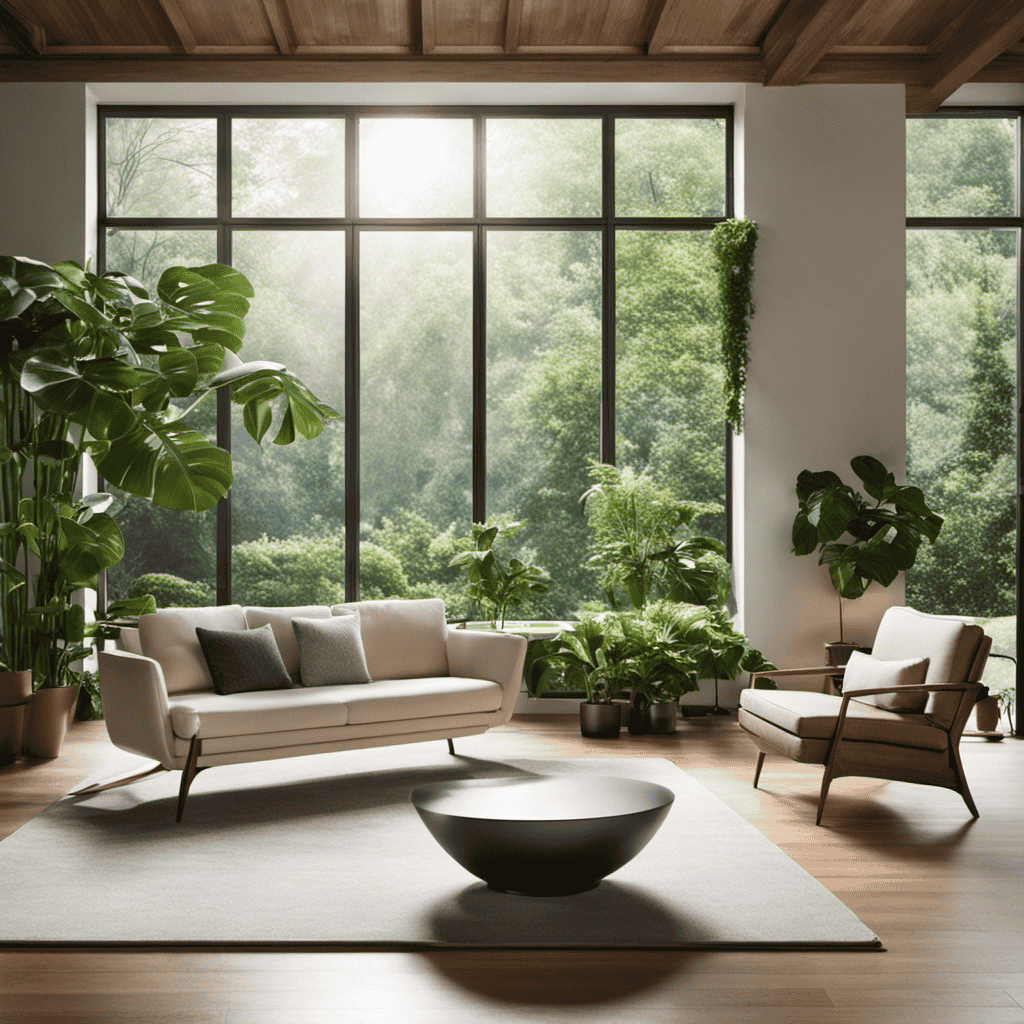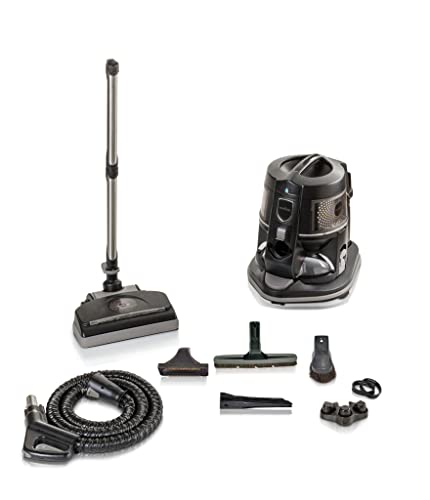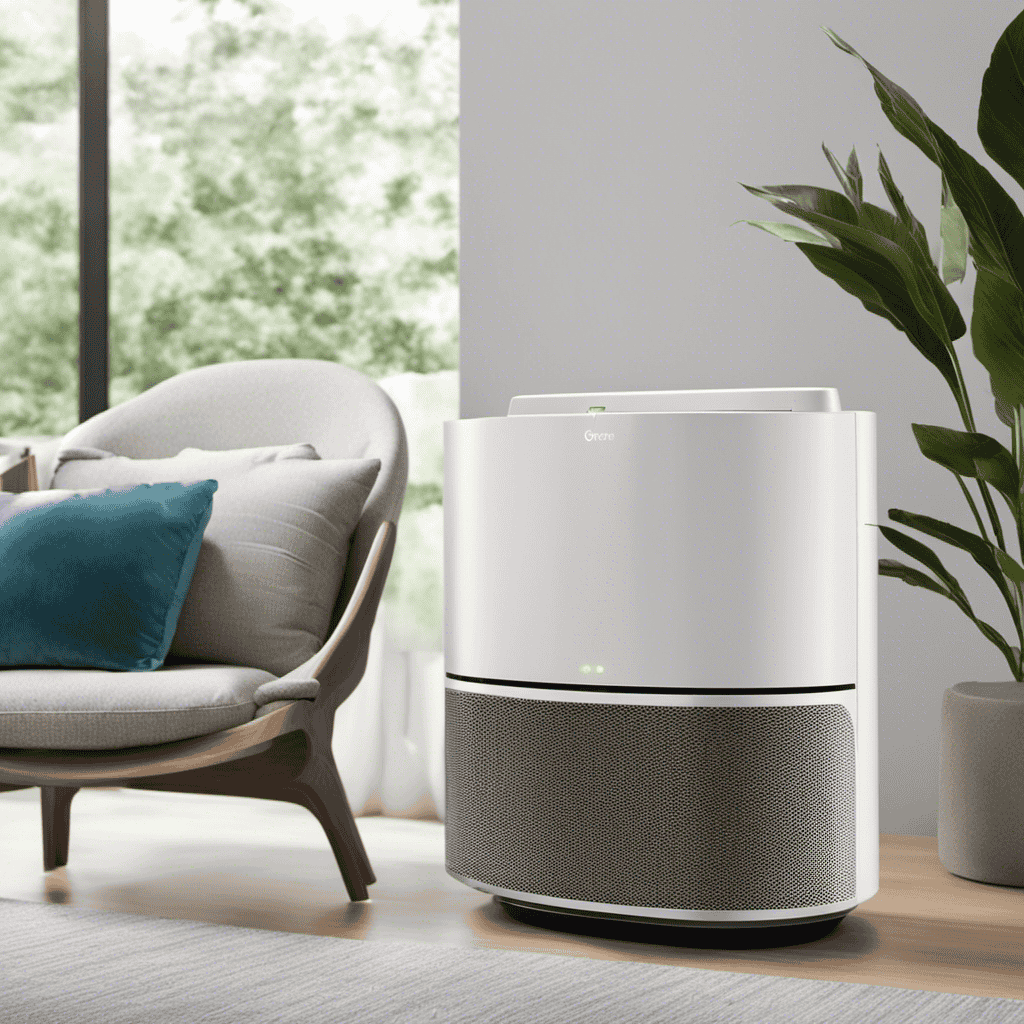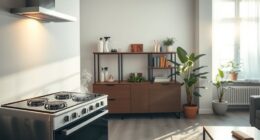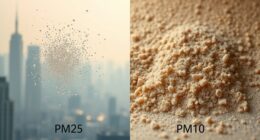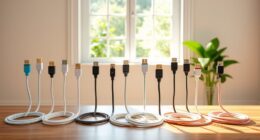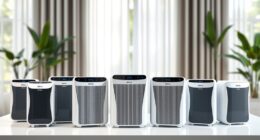As someone who is dedicated to enhancing indoor air quality, I frequently think about the challenging decision of where to position an air purifier. The right placement is crucial for getting the most out of the purifier and guaranteeing that clean, fresh air flows effectively throughout your area.
In this article, we will delve into the intricacies of air purifier placement, considering room size, specific areas like the bedroom, living room, and kitchen, as well as tips for positioning multiple purifiers for optimal results.
Let us embark on this journey to discover the ideal location for your air purifier.
Key Takeaways
- Proper placement of an air purifier is crucial for maximizing its efficiency and effectiveness.
- Consider the room layout, air quality benefits, and room size when determining the placement of an air purifier.
- Place the air purifier in a central location with good airflow and ventilation for optimal air circulation.
- Avoid placing the air purifier near walls, furniture, or corners that obstruct airflow, and keep it away from potential sources of pollutants.
Importance of Placement
The placement of an air purifier is crucial in order to effectively filter and purify the surrounding air. When determining where to place your air purifier, it is important to consider the room layout and the air quality benefits you are seeking.
Ideally, the air purifier should be placed in a central location within the room, allowing for maximum air circulation and coverage. Avoid placing the purifier near walls or furniture that may obstruct airflow. Additionally, consider placing the purifier away from potential sources of pollutants such as smoking areas or chemical storage.
Consider Room Size
When it comes to placing an air purifier, it is important to consider the dimensions of the room. The size of the room can greatly affect the effectiveness of the air purifier in removing pollutants and improving air quality.
Optimal location considerations should also be taken into account, such as placing the air purifier in an area with good airflow and away from obstacles that may obstruct its performance.
Air Purifier Placement
To maximize effectiveness, it’s important to consider the placement of an air purifier in your home. Proper placement can ensure that the air purifier effectively removes pollutants and improves indoor air quality. Here are some key factors to consider when deciding where to place your air purifier:
| Factors to Consider | Placement Options |
|---|---|
| Proximity to Pollution Sources | Place the air purifier near potential sources of pollution such as kitchens, bathrooms, or areas with high foot traffic. |
| Airflow and Ventilation | Position the air purifier in an area with good airflow and ventilation to allow for efficient circulation of clean air. Avoid placing it in corners or behind furniture that may obstruct airflow. |
| Room Size | Consider the square footage of the room and choose an air purifier with an appropriate coverage area to effectively clean the air. |
Room Dimensions Matter
Consider the size of your room and how it may impact the effectiveness of your air purifier.
When choosing an air purifier, it is crucial to select the right size for your room. A purifier that is too small will struggle to clean the air effectively, while one that is too large may be unnecessarily expensive and take up too much space.
To determine the appropriate size, measure the square footage of your room and refer to the manufacturer’s guidelines.
Additionally, take into account the noise level of the air purifier. Some models can be quite loud, especially on higher fan speeds, which may be disruptive in smaller rooms or during sleep. Opt for a quieter option if noise is a concern.
Optimal Location Considerations
For the best results, make sure you place your air purifier in a central area of the room. This ensures that the purified air can circulate evenly throughout the space, maximizing its effectiveness. When considering the placement of an air purifier in an office cubicle, it is important to take into account the size and layout of the cubicle. In a small cubicle, placing the air purifier on a desk or shelf near the center of the space would be ideal. In larger cubicles, it may be beneficial to place the air purifier near the entrance or in a corner, allowing it to capture and filter air from a wider area. In dorm rooms, placing the air purifier on a nightstand or desk in the center of the room would be a good choice. Additionally, consider the proximity to potential sources of pollutants such as windows or doors. By strategically placing the air purifier, you can create a clean and healthy environment in your workspace or dorm room.
| Considerations for Office Cubicles | Air Purifier Placement in Dorm Rooms |
|---|---|
| Size and layout of cubicle | Placement on nightstand or desk |
| Placement on desk or shelf in small cubicle | Proximity to windows or doors |
| Placement near entrance or in a corner in larger cubicles | Central location in the room |
Placement in the Bedroom
You’ll want to place the air purifier in your bedroom to ensure clean and fresh air while you sleep. Not only does this location provide you with the most direct benefit, but it also allows you to incorporate the air purifier into your room decor seamlessly.
Here are some reasons why placing the air purifier in your bedroom is a great idea:
-
Improved Sleep Quality: Breathing in clean air can help you sleep better and wake up refreshed.
-
Allergy Relief: If you suffer from allergies, having an air purifier in your bedroom can reduce allergens and provide relief.
-
Noise Level: Air purifiers typically have a noise level that is suitable for a bedroom environment, ensuring a peaceful sleep.
-
Odor Elimination: Whether it’s pet odors or cooking smells, an air purifier can help remove unwanted odors from your bedroom.
Placing an air purifier in your bedroom is a practical and beneficial choice.
Ideal Location in the Living Room
When it comes to optimal placement for an air purifier in the living room, there are a few key points to consider.
First, it is important to place the purifier in an area where it can effectively circulate the air throughout the room. This means avoiding placing it behind furniture or in corners where air circulation may be limited.
Additionally, positioning the purifier near potential sources of pollutants, such as near an open window or near a smoking area, can help improve its effectiveness in cleaning the air.
Optimal Placement for Air Purifier
To maximize effectiveness, it’s important to place your air purifier in an area with good air circulation. This ensures that the purifier can effectively filter and clean the surrounding air, improving the overall air quality in your home.
The importance of air quality cannot be overstated, as it directly impacts our health and well-being. Here are four reasons why optimal placement of an air purifier is crucial:
-
Reduced allergy symptoms: By placing the air purifier in a room where you spend a lot of time, such as the bedroom or living room, you can minimize the presence of allergens like dust, pollen, and pet dander, leading to a significant reduction in allergy symptoms.
-
Improved respiratory health: Breathing in clean air can have a positive impact on our respiratory system. By placing the air purifier in a strategic location, you can reduce the presence of harmful pollutants, such as smoke, mold spores, and volatile organic compounds, which can cause respiratory issues.
-
Enhanced sleep quality: Placing the air purifier in the bedroom can help improve sleep quality by filtering out pollutants and allergens that can disrupt sleep. This can lead to a more restful and rejuvenating night’s sleep.
-
Increased overall well-being: Breathing clean air has been linked to various health benefits, including improved mood, increased energy levels, and reduced stress. By placing the air purifier in the right location, you can create a healthier and more comfortable living environment, contributing to your overall well-being.
Effective Air Circulation
Now that we have discussed the optimal placement for an air purifier, let’s explore effective air purification techniques and the benefits of clean air in the home.
When it comes to air purification, there are various techniques that can be employed to ensure the air in your home remains clean and healthy. One effective technique is the use of High Efficiency Particulate Air (HEPA) filters, which can remove up to 99.97% of airborne particles, including dust, pollen, and pet dander. Another technique is the use of activated carbon filters, which can adsorb odors, chemicals, and volatile organic compounds (VOCs).
The benefits of having clean air in your home are numerous. Clean air can improve respiratory health, reduce allergies and asthma symptoms, and enhance overall well-being. It can also help eliminate unpleasant odors and create a more pleasant living environment.
Air Purifier Placement in the Kitchen
If you want to improve the air quality in your kitchen, place the air purifier near the stove and other cooking areas. By doing so, you can effectively remove harmful pollutants and odors that are often generated during cooking.
Here are some benefits of having an air purifier in the kitchen:
-
Reduced cooking odors: An air purifier can help eliminate strong cooking odors, leaving your kitchen smelling fresh and clean.
-
Removal of airborne contaminants: Cooking can release particles such as grease, smoke, and allergens into the air. An air purifier can filter out these contaminants, improving the overall air quality.
-
Healthier indoor environment: With an air purifier, you can reduce exposure to pollutants like volatile organic compounds (VOCs), which can have negative health effects.
-
Improved respiratory health: By removing airborne particles and allergens, an air purifier can help alleviate respiratory symptoms and improve breathing for those with allergies or asthma.
Placing an air purifier in your kitchen can significantly benefit your kitchen air quality and overall well-being.
Putting an Air Purifier in the Bathroom
When considering a bathroom air purifier, it’s important to choose a model that is specifically designed for small spaces and can effectively remove odors and contaminants caused by moisture and bacteria.
Bathroom air quality can be compromised due to the high humidity levels and the presence of bacteria and mold. An air purifier can help improve the air quality in the bathroom by capturing and eliminating these pollutants.
The benefits of bathroom air purification include reducing unpleasant odors, preventing the growth of mold and mildew, and reducing the spread of bacteria and viruses.
Best Spot for an Air Purifier in the Office
When it comes to maximizing the effectiveness of an air purifier in the office, ideal placement is crucial.
Considerations for office layout play a significant role in determining the best spot for the air purifier.
Ideal Placement for Effectiveness
The best place to put an air purifier is in a central location, such as the living room or bedroom, for maximum effectiveness. Placing it in a central location ensures that the air purifier can circulate clean air throughout the room and reach all corners.
When considering the room layout and ventilation options, there are a few key factors to keep in mind:
-
Proximity to pollution sources: Position the air purifier close to potential sources of pollutants, such as windows or doors, to capture airborne contaminants before they spread.
-
Adequate airflow: Ensure that the air purifier is not obstructed by furniture or other objects, allowing for efficient air circulation.
-
Size of the room: Choose an air purifier with a suitable coverage area that aligns with the size of the room for optimal purification.
-
Noise level: Consider placing the air purifier away from areas where you spend the most time, like your bed or work desk, to minimize any noise disturbance.
Considerations for Office Layout
To ensure optimal air quality in your office, consider the layout and placement of your air purifier. Office productivity and employee well-being are directly linked to the air quality in the workspace. When deciding where to place your air purifier, it is important to consider factors such as the size of the office, the number of employees, and the presence of any pollutants or allergens.
Ideally, the air purifier should be placed in a central location to ensure that the purified air is evenly distributed throughout the office. It should also be positioned away from walls or furniture to allow for proper air circulation. Additionally, make sure to regularly clean and maintain the air purifier to ensure its effectiveness.
By carefully considering the layout and placement of your air purifier, you can create a healthier and more productive office environment.
When it comes to considerations for placing an air purifier in a nursery or child’s room, there are a few important factors to keep in mind.
Considerations for Placing in a Nursery or Child’s Room
Make sure you place the air purifier in a nursery or child’s room away from potential hazards like cords or curtains. It is important to consider the room decor and noise levels when selecting the best location for the air purifier. Here are some key points to keep in mind:
-
Opt for a compact and stylish air purifier that complements the room decor. This way, it won’t stick out like a sore thumb and ruin the aesthetic appeal.
-
Choose an air purifier with a quiet operation. Babies and young children are sensitive sleepers, so you don’t want a noisy machine disturbing their rest.
-
Ensure that the air purifier is placed in a central location within the room to maximize its effectiveness in filtering the air.
-
Regularly clean and maintain the air purifier to ensure it is functioning at its best and providing clean air for your little one.
With these considerations in mind, you can create a safe and healthy environment for your child.
Now, let’s explore the placement of air purifiers in a pet-friendly home.
Placement in a Pet-Friendly Home
When it comes to placing an air purifier in a pet-friendly home, there are several key points to consider.
One important factor is to position it in high-traffic areas for effective odor control.
It is also crucial to place the air purifier away from pet beds to avoid any discomfort for the pets.
Additionally, placing the air purifier near the litter box can help minimize any unpleasant odors associated with it.
High-Traffic Areas for Odor Control
In high-traffic areas like the kitchen or living room, you should place an air purifier to effectively control odors. These areas tend to accumulate cooking smells, pet odors, and general household odors, which can be unpleasant and linger in the air. An air purifier can help eliminate these odors, leaving the space smelling fresh and clean.
Here are four reasons why placing an air purifier in high-traffic areas is beneficial:
-
Improved indoor air quality: The air purifier filters out pollutants, allergens, and odor-causing particles, improving the overall air quality in the room.
-
Odor elimination: The purifier’s activated carbon filter absorbs and neutralizes odors, effectively removing unpleasant smells from the air.
-
Health benefits: By reducing airborne particles and contaminants, an air purifier can help alleviate respiratory issues and allergies.
-
Peace of mind: Knowing that the air in high-traffic areas is clean and odor-free can provide a sense of comfort and well-being.
When it comes to keeping your pet’s bed area fresh and odor-free, it is essential to place the air purifier away from pet beds to avoid any discomfort or disturbances for your furry friend.
Away From Pet Beds
When it comes to placing an air purifier in your home, it’s important to consider the ideal location for pets and the best placement for allergies.
One key consideration is to keep the air purifier away from pet beds. While we love our furry friends, they can carry allergens such as pet dander, fur, and saliva. Placing the air purifier near their beds may help reduce these allergens, but it can also disturb your pets’ sleep and make them uncomfortable.
Instead, it is recommended to place the air purifier in a central location within the room, away from pet beds. This will help ensure that the purifier can effectively filter the air and remove allergens, while still providing a comfortable environment for your pets.
Near Litter Box
To minimize odors and keep the air fresh, it’s important to keep the air purifier near your cat’s litter box. This ideal placement allows the purifier to effectively control the strong odors that can emanate from the litter box.
Here are some reasons why this placement is beneficial:
-
Improved air quality: Placing the air purifier near the litter box ensures that any odors are captured and filtered out. This helps to maintain a clean and fresh-smelling environment in your home.
-
Reduced allergens: Cats can produce allergens that may cause discomfort for some individuals. By placing the air purifier near the litter box, it can help to remove these allergens from the air, providing relief for those with allergies.
-
Enhanced convenience: Placing the air purifier near the litter box means it is easily accessible for maintenance and filter changes. This ensures that the purifier remains effective in odor control.
-
Peace of mind: With the air purifier near the litter box, you can have peace of mind knowing that you are taking proactive steps to minimize odors and maintain a fresh atmosphere in your home.
Positioning the Air Purifier in a Basement
Consider placing the air purifier in a central location, such as the middle of the basement, to ensure maximum air circulation and purification. This is crucial for maintaining a healthy indoor environment, especially in basements where humidity levels can be higher compared to other areas of the house.
Basement air purification is beneficial for several reasons. Firstly, it helps to remove musty odors and reduce the risk of mold and mildew growth. Secondly, it filters out allergens and pollutants, improving air quality and reducing the risk of respiratory issues. Lastly, it can help regulate humidity levels, preventing excess moisture that can lead to structural damage and health problems.
By positioning the air purifier in the middle of the basement, it can effectively circulate and purify the air throughout the entire space.
Now, let’s explore the next section on putting an air purifier in an open floor plan.
Putting an Air Purifier in an Open Floor Plan
If you have an open floor plan, it’s important to strategically place the air purifier to ensure proper air circulation throughout the entire space. The ideal placement for an air purifier in an open floor plan is determined by several factors, including the size of the room, the layout of furniture, and the location of potential pollutants.
Here are some benefits of having an air purifier in an open floor plan:
- Improved indoor air quality, reducing allergens and pollutants
- Enhanced respiratory health, reducing the risk of allergies and asthma
- Elimination of odors, creating a fresh and clean environment
- Increased overall comfort, providing a sense of well-being and relaxation
Considerations for Placing in a Home Gym
Placing an air purifier in a home gym is a smart decision for maintaining a clean and healthy exercise environment. Not only does it help to remove airborne allergens and pollutants, but it also provides several other benefits.
One important consideration when choosing an air purifier for a home gym is the noise level. It is crucial to select a model that operates quietly, as you wouldn’t want the noise to interfere with your workout sessions.
Additionally, an air purifier can help eliminate unpleasant odors that may arise from sweating and working out. This is especially beneficial if your home gym is located in a basement or a closed space with limited ventilation.
Improved air quality can enhance your workout experience and help you achieve your fitness goals in a comfortable and refreshing environment.
Ideal Location for an Air Purifier in a Studio Apartment
The best spot for an air purifier in a studio apartment is near the main living area, where it can efficiently filter and circulate the air. Placing the air purifier in this location ensures that it can effectively remove pollutants and allergens, providing you with clean and fresh air to breathe.
Here are four reasons why this is the optimal location for an air purifier:
-
Improved air quality: By placing the air purifier near the main living area, it can target the most frequently used space in your apartment, ensuring that you breathe in clean air where you spend the most time.
-
Enhanced circulation: The air purifier strategically placed in the main living area can circulate the purified air throughout the apartment, reaching every corner and providing a consistent flow of clean air.
-
Minimized pollutant buildup: Placing the air purifier near the main living area helps prevent pollutants from settling and accumulating in other areas of the apartment, ensuring that the air remains fresh and clean.
-
Convenience: Having the air purifier near the main living area allows for easy access and maintenance, making it more convenient for you to monitor its performance and change filters when needed.
Placement in a High-Traffic Area
When considering the placement of an air purifier in a studio apartment, you’ll want to choose a high-traffic area. This ensures that the air purifier can effectively circulate and clean the air throughout the entire space.
By placing it in a high-traffic area, such as a living room or bedroom, you increase the chances of the air purifier capturing airborne pollutants and contaminants. This is especially important for individuals with allergies or respiratory issues, as it can help improve indoor air quality and reduce symptoms.
Additionally, placing the air purifier in a high-traffic area makes it more convenient for air purifier maintenance. Regular maintenance, such as changing filters and cleaning the unit, is crucial to ensure optimal performance and longevity of the air purifier.
Tips for Properly Positioning Multiple Air Purifiers
To ensure optimal effectiveness, it is important to consider positioning multiple air purifiers strategically throughout your space. This will help to cover a larger area and ensure that every corner of the room is well-filtered.
When it comes to the size of the air purifiers, it is important to choose ones that are suitable for the room size. Larger rooms may require larger air purifiers to efficiently clean the air.
Additionally, noise levels should be taken into consideration. Some air purifiers can be quite loud, which may be disruptive in certain areas such as bedrooms or offices. It is recommended to look for air purifiers that have low noise levels or offer a quiet mode to minimize any disturbances.
In summary:
- Larger air purifiers are suitable for bigger rooms.
- Low noise levels are important for peaceful environments.
- Strategically place air purifiers for optimal coverage.
- Choose air purifiers that are suitable for the size of the room.
Is There a Specific Location That’s Best for Placing an Air Purifier?
When it comes to finding the best placement for air purifier, the ideal location is near the center of the room to ensure optimal air circulation. Placing the air purifier away from walls or large furniture will also help maximize its effectiveness in eliminating airborne impurities.
Frequently Asked Questions
Can I Put an Air Purifier in a Small Room or Will It Be Less Effective?
I can place an air purifier in a small room, but its effectiveness may be reduced. The size of the room affects the purifier’s ability to circulate and clean the air thoroughly.
Is It Safe to Place an Air Purifier in the Kitchen Due to Potential Heat or Moisture Damage?
I wouldn’t recommend placing an air purifier in the kitchen due to potential heat and moisture damage. It’s safer to put it in other rooms, like the living room or bedroom, where it can effectively reduce odors and pollutants.
What Are the Benefits of Having an Air Purifier in the Bathroom?
Having an air purifier in the bathroom can help improve indoor air quality by removing odors and reducing moisture levels. It’s important to place it in a well-ventilated area and to regularly maintain it to ensure its effectiveness.
Is It Recommended to Have an Air Purifier in an Office With Multiple People?
In an office with multiple people, it is recommended to place the air purifier in a central location to maximize its effectiveness. Consider noise levels and regular maintenance to ensure optimal air quality for everyone.
How Should I Position an Air Purifier in a Nursery or Child’s Room to Ensure Maximum Effectiveness?
To ensure maximum effectiveness of an air purifier in a nursery or child’s room, position it in a central location away from obstacles. This helps to circulate clean air evenly and reduces the impact of pollutants on children’s health.
Conclusion
In conclusion, proper placement of an air purifier is crucial for optimal air purification.
Just as a gardener strategically places plants to ensure their growth, so should we strategically place our air purifiers to ensure the cleanest air possible.
By considering room size, specific room locations, and even high-traffic areas, we can create a healthier living environment.
So, let’s become the gardeners of our indoor air quality, placing our air purifiers like seeds that will blossom into fresh, pure air throughout our homes.
